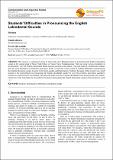| dc.contributor.author | Herman | |
| dc.date.accessioned | 2018-03-16T04:20:40Z | |
| dc.date.available | 2018-03-16T04:20:40Z | |
| dc.date.issued | 2016-10-17 | |
| dc.identifier.citation | Alotaibi, A. N., Celce-Murcia, M, et al, Kelly, G., Kenworthy. J | en_US |
| dc.identifier.issn | 2380-2529 | |
| dc.identifier.uri | http://repository.uhn.ac.id/handle/123456789/523 | |
| dc.description.abstract | This research is conducted in order to find out the most difficult position in pronouncing the English labiodental sounds at the second grade of Senior High School of Taman Siswa Pematangsiantar. There are some various articulators in pronunciation. They are bilabial, labiodental, dental, alveolar, palatoalveolar, palatal, velar, and glottal. For Indonesian students, there are some articulators are difficult to pronounce. In this research, the writer focuses on students’ difficulties in pronouncing the English labiodental sounds. It can be in the initial, medial, and final position. Problem discussed in this research was: which position is the most difficult in pronouncing the English labiodental sounds? To solve the problem, descriptive qualitative method was implemented in this research. The data were taken from each English labiodental word pronounced by the students. Finally, the writer found that: the most difficult position in pronouncing the English labiodental sounds is final position in sound / v /. | en_US |
| dc.language.iso | en | en_US |
| dc.publisher | Science Publishing Group (Science PG) | en_US |
| dc.relation.ispartofseries | Vol. 2;No. 1 | |
| dc.subject | Students’ Pronunciation, Difficulty, Labiodental Sounds | en_US |
| dc.title | Students’ Difficulties in Pronouncing the English Labiodental Sounds | en_US |
| dc.type | Article | en_US |

